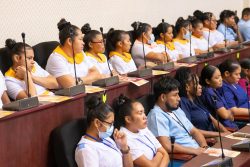In February this year the government estimate of migrants entering Guyana from Venezuela was around 40,000. This comprised nationals of the country, Guyanese Venezuelans who had lived there for several decades as well as nationals from other countries who had been living in Venezuela. According to immigration records the figure was 20,000, but it was explained that the difference was accounted for by a distinction being made between those who had been born in Guyana but had lived in Venezuela for a long time and were not recorded as migrants when they returned with their families, and those who were not born here. Whatever the true figure is it still represents the kind of immigrant numbers not seen in this country since the nineteenth century.
The border controversy it seems has not proved an impediment to arrivals, but then in the 1980s it was no disincentive to Guyanese going in the other direction either; those living in conditions of hardship are rarely bothered by matters of international discord. It is of course the ultimate irony that in that earlier period an arrogant Venezuela offered all Essequibans Venezuelan passports – as it was they never put the bureaucratic protocols in place to make that possible – and now not only are Venezuelans leaving their homeland to come here, but some of them, one suspects, would be happy to have a Guyanese passport.
In general ordinary Guyanese have not been unwelcoming; they well remember the days when so many of their compatriots were given shelter in Venezuela and they consider it only fair they should return the courtesy. While for a small population like ours the numbers arriving are significant, they are but a tiny fraction of the totals leaving our neighbour to the west. As of March 28 this year an inter-agency group led by UNHCR and the International Organization for Migration estimated the number of Venezuelan refugees and migrants in the world at 7,239,953, of which 6,095,464 had taken refuge in Latin America and the Caribbean.
While it gets comparatively little international coverage in contrast to the exodus from Syria, Iran and Afghanistan especially, the Venezuelan migrant situation is one of the largest refugee crises in the world.
The reason for it not being the focus of international media attention is that Middle Eastern and African refugees and migrants try to enter Europe which is hostile to their entry, while in a general sense Venezuelans have found South American nations more accommodating. According to the Refugee and Migrant Needs Analysis of October 2022, almost three-quarters of migrants and refugees in Latin America and the Caribbean are “people in need”. The highest number in need were to be found in the Dominican Republic (88.3%), but after that came Trinidad and Tobago at 86.3%. Inevitably, Colombia which has accepted by far the largest number of Venezuelans – around 2½ million ‒ also came in for mention.
The situation in Guyana is not clear, although the government has made reference to the Venezuelan Warraus who have counterparts on our side of the border. They were said to be very poor, with few resources, in addition to which they had had no access to immunization, health services and education in their homeland. How effective the government has been in providing for them in recent times is not known after some of them were removed in March last year from Kabakaburi to a camp of 200 at Khan Hill, where resources were inadequate. One resident sent a photo of them scavenging in the garbage at Mabaruma.
This newspaper has carried the occasional success story too, although the most recent case of a caterer involved someone whose family had Guyanese origins and who still had connections in this country. For this category of migrants the situation would be much easier. The circumstances of most of those born in Venezuela is a matter for conjecture. Certainly there was the case recently of a Venezuelan woman who appeared in court in relation to running a brothel. It is thought that more than half the Venezuelans who come here are women, and it is also known that some of them may be victims of trafficking in persons, although the extent of the problem is simply unknown.
In connection with this the day before yesterday Parliament in a rare show of unanimity passed a trafficking in persons Bill, AG Anil Nandlall noting, “Guyana has porous borders and these borders are often exploited for trafficking in persons and human smuggling.”
That specific issue aside, it would be helpful to know to what extent the majority of Venezuelans are assimilating here, how many of them are working and what their occupation is, whether all their children are in school and questions of that ilk. The government has a Multi-Agency Coordinating Committee to address the influx of Venezuelan migrants into Guyana, and the last meeting of March 8 which was publicised, was convened by the Foreign Affairs Ministry and attended by representatives of government agencies as well as international organisations. The administration has had help from the latter and one would like to believe the Committee has data at its disposal which could be shared with the public.
The purpose would not be to invite criticism of government efforts or register opposition to the presence of the newcomers; after all, Guyana has always been an immigrant society. The idea rather would be to give citizens information on the social changes which are currently in process. The society is undergoing transformation in all kinds of ways, and the arrival of so many migrants is a development which provides an opportunity to see whether groups can manage to integrate in our complicated world, and what strategies they use to survive; or alternatively, how many are continuously dependent on assistance from the government or external agencies.
Economically speaking the situation in Venezuela has improved a little, with inflation falling from what the Economist calls “an almost unmeasurable peak” in early 2019 to around 500%.
This has been made possible by allowing the use of US dollars. In addition the war in Ukraine has helped somewhat, with Washington anxious to augment global energy supplies and showing a preparedness in principle at least to relax some sanctions, and in practice to allow Chevron to receive Venezuelan oil for payment of debts it is owed. However, the slight economic improvements, it has been reported, have really only benefited the better off; the poor remain as poor as ever. As such, the arrivals here from Venezuela may continue for some time yet.








